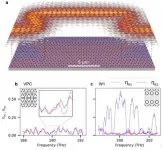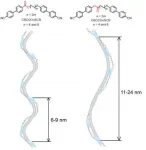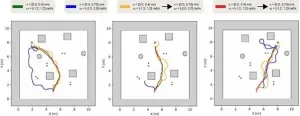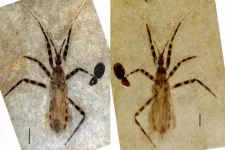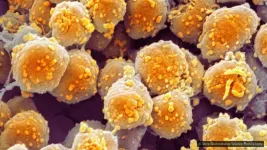Armouring anti-cancer T cells against immunosuppressants
2021-01-19
(Press-News.org) SINGAPORE, 19 January 2021 - Duke-NUS Medical School researchers, together with collaborators in Singapore, have designed armoured immune cells that can attack recurring cancer in liver transplant patients, while temporarily evading immunosuppressant drugs patients take to avoid organ rejection. The findings were published in the journal Hepatology.
Hepatocellular carcinoma is the most common type of primary liver cancer and the sixth most common cancer worldwide. It often develops in people with chronic liver disease following hepatitis B infection.
A common treatment for hepatocellular carcinoma is to completely remove the liver and replace it with a healthy one from a donor. However, hepatitis B-related hepatocellular carcinoma can recur in some patients following transplantation. To kill the cancer, doctors can inject immune cells, called T cells, which are specially designed to target hepatitis B material found in the cancer cells. However, liver transplant patients must take drugs that suppress their immune systems to prevent their bodies from attacking the transplants. This significantly hinders the effectiveness of T cell therapy.
"We developed a method to make T cells that specifically target the hepatitis B antigen in liver cancer cells while, at the same time, making them resistant to two commonly used immunosuppressants: tacrolimus and mycophenolate mofetil," said Professor Antonio Bertoletti, senior author of the study from Duke-NUS' Emerging Infectious Diseases Programme.
"Importantly, the resistance of our T cells to the immunosuppressants only lasted for about four days after which they regain their sensitivity to the drugs," added Prof Bertoletti.
This transient effect, a result of the engineering approach the team used, provides an additional layer of safety to minimise the possibility of organ rejection.
Prof Bertoletti and his colleagues began their investigations by testing the effects of tacrolimus and mycophenolate mofetil on T cells designed with a special receptor that targets hepatitis B antigens located on liver cancer cells. They found that both drugs significantly reduced the T cells' ability to kill the cancer cells.
The team then re-designed the T cells by adding genetic codes that disrupt the enzymes needed by the two drugs to suppress immune cells. They found that these 'immunosuppressive drug resistant armoured hepatitis B T cell receptor' (IDRA HBV-TCR) T cells showed "superior killing" power of hepatocellular carcinoma cell targets for up to four days.
"We also found that this strategy can be applied to target other pathologies that commonly occur in transplant patients receiving immunosuppressive drugs, like Epstein-Barr virus and cytomegalovirus reactivations," said Dr Anthony T Tan, a senior research fellow in Prof Bertoletti's lab and a co-author of the study.
"Innovative research like this lays the foundation for new discoveries and transformative change," said Professor Patrick Casey, Senior Vice-Dean for Research, Duke-NUS Medical School. "With waiting lists for organs lengthening around the world, ensuring that those patients who benefit from a much-needed transplant can remain in remission is a significant advance and offers much hope."
The team next aims to apply their approach in clinical trials.
INFORMATION:
ELSE PRESS RELEASES FROM THIS DATE:
2021-01-19
Topologically tailored photonic crystals (PhC) have opened up the possibility for attaining robust unidirectional transport of classical and quantum systems. The demand for unprecedented guiding capabilities that support unhindered transport around imperfections and sharp corners at telecom wavelengths, without the need for any optimization, is fundamental for efficient distribution of information through dense on-chip photonic networks. However, transport properties of experimental realizations of such topologically non-trivial states have been inferred by transmission measurements and even though robustness ...
2021-01-19
Overview:
A team of researchers led by Assistant Professor Yuki Arakawa (Toyohashi University of Technology, Japan) has successfully developed sulfur-containing liquid crystal (LC) dimer molecules1) with oppositely directed ester bonds, which exhibit a helical liquid crystal phase, viz. twist-bend nematic (NTB) phase, 2) over a wide temperature range, including room temperature. Collaboration with a team at the Advanced Light Source research facility (Lawrence Berkeley National Laboratory, USA) revealed that the ester bond direction in the molecular structures largely impacts the pitch lengths of helical nanostructures in the NTB phase. It is expected that this molecular design ...
2021-01-19
Overview:
A research group from the Active Intelligent System Laboratory (AISL) at Toyohashi University of Technology (TUT) has proposed a new framework for training mobile robots to quickly navigate while maintaining low collision rates. The framework combines deep reinforcement learning (DRL) and curriculum learning in the training process for robots to learn a fast but safe navigation policy.
Details:
One of the basic requirements of autonomous mobile robots is their navigation capability. The robot must be able to navigate from its current position to the specified target position ...
2021-01-19
CHAMPAIGN, Ill. -- The fossilized insect is tiny and its genital capsule, called a pygophore, is roughly the length of a grain of rice. It is remarkable, scientists say, because the bug's physical characteristics - from the bold banding pattern on its legs to the internal features of its genitalia - are clearly visible and well-preserved. Recovered from the Green River Formation in present-day Colorado, the fossil represents a new genus and species of predatory insects known as assassin bugs.
The find is reported in the journal Papers in Palaeontology.
Discovered in 2006 by breaking open ...
2021-01-19
Simple vision tests can predict which people with Parkinson's disease will develop cognitive impairment and possible dementia 18 months later, according to a new study by UCL researchers.
The study, published in Movement Disorders, adds to evidence that vision changes precede the cognitive decline that occurs in many, but not all, people with Parkinson's.
In another new study published today in Communications Biology, the same research team found that structural and functional connections of brain regions become decoupled throughout the entire brain in people with Parkinson's disease, particularly among people with vision problems.
The ...
2021-01-19
There are high hopes for the next generation of high energy-density lithium metal batteries, but before they can be used in our vehicles, there are crucial problems to solve. An international research team led by Chalmers University of Technology, Sweden, has now developed concrete guidelines for how the batteries should be charged and operated, maximising efficiency while minimising the risk of short circuits.
Lithium metal batteries are one of several promising concepts that could eventually replace the lithium-ion batteries which are currently widely used - particularly in various types of electric vehicles.
The big advantage of this new battery type is that the energy density can be significantly ...
2021-01-19
New research suggests a unique program called Moms2B at The Ohio State University Wexner Medical Center shows a reduction in adverse pregnancy outcomes in communities disproportionately affected by these public health issues.
The study, led by researchers Courtney Lynch and Erinn Hade and published in the Journal of Maternal and Child Health, indicates that women who attended at least two Moms2B sessions may have lower rates of preterm birth, low birth weight and infant mortality compared to women who only received individual care.
"When we started the program 10 years ago, ...
2021-01-19
New study identifies a bizarre new species suggesting that giant marine lizards thrived before the asteroid wiped them out 66 million years ago.
A new species of mosasaur - an ancient sea-going lizard from the age of dinosaurs - has been found with shark-like teeth that gave it a deadly slicing bite.
Xenodens calminechari, from the Cretaceous of Morocco, had knifelike teeth that were packed edge to edge to make a serrated blade and resemble those of certain sharks. The cutting teeth let the small, agile mosasaur, about the size of a small porpoise, punch above its weight, cutting fish in half and taking large bites from bigger animals.
Dr Nick Longrich, Senior Lecturer at the Milner Centre for Evolution at the University of Bath and lead author on ...
2021-01-19
Clumsy kids can be as aerobically fit as their peers with better motor skills, a new Finnish study shows. The results are based on research conducted at the Faculty of Sport and Health Sciences of the University of Jyväskylä and the Institute of Biomedicine of the University of Eastern Finland, and they were published in Translational Sports Medicine.
Aerobic fitness doesn't go hand in hand with motor skills
According to the general perception, fit kids also have good motor skills, while low aerobic fitness has been thought to be a link ...
2021-01-19
A group of international scientists, including an Australian astrophysicist, has used knowhow from gravitational wave astronomy (used to find black holes in space) to study ancient marine fossils as a predictor of climate change.
The research, published in the journal Climate of the Past, is a unique collaboration between palaeontologists, astrophysicists and mathematicians - to improve the accuracy of a palaeo-thermometer, which can use fossil evidence of climate change to predict what is likely to happen to the Earth in coming decades.
Professor Ilya Mandel, from the ARC Centre of Excellence in Gravitational Wave Discovery (OzGrav), and colleagues, studied biomarkers left behind by tiny single-cell organisms called archaea in the distant past, including the Cretaceous period ...
LAST 30 PRESS RELEASES:
[Press-News.org] Armouring anti-cancer T cells against immunosuppressants
